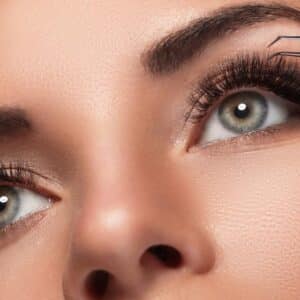Brown is the Most Common Eye Color in the World
Brown is the most common eye color in the world, with more than half of the global population having brown eyes. This is due to the presence of melanin, a pigment that gives color to the eye’s iris. The amount of melanin in the iris determines the color of the eyes. Brown eyes have more melanin than blue eyes, which have very little melanin. Green and hazel eyes are intermediate in terms of melanin content, with green eyes having slightly less melanin than brown eyes and hazel eyes having slightly more.
While brown is the most common eye color, it is not the only eye color found in the world. There is a wide range of eye colors, including blue, green, grey, and even violet. Eye color is inherited and is determined by the genes that a person inherits from their parents. A person can have blue eyes, for example, even if both parents have brown eyes. This is because multiple genes determine eye color, and combinations can produce different eye colors.
Eye color can change over time, although this is more common in children. As children grow and their eyes mature, their eye color may become darker or lighter. This is due to the continuing production of melanin in the iris. In some cases, the eye color may also change due to illness or injury, although this is rare.
While eye color is primarily determined by genetics, it can also be affected by environmental factors such as sun exposure. The amount of melanin in the iris can be increased or decreased by exposure to the sun, which can cause the eye color to become darker or lighter. However, these changes are usually temporary, and the eye color will return to its normal shade once the person is no longer exposed to the sun.
Brown is the most common eye color in the world, with more than half of the global population having brown eyes. While brown is the most common eye color, there is a wide range of eye colors found in the world, and eye color is determined by genetics and can be affected by environmental factors such as sun exposure.
Blue and Green are Rare For Brown-Eyed People
Blue and green eyes are relatively rare in the world, with an estimated 8% of the global population having blue eyes and only 2% having green eyes. These eye colors are often thought to be particularly striking and attractive, with many people finding them particularly appealing.
While brown eyes are the most common eye color, with an estimated 79% of the world’s population having brown eyes, it is possible for people with brown eyes also to have blue or green eyes. This is because the color of someone’s eyes is determined by the amount and type of pigment in the iris and can be influenced by genetics and other factors.
In some cases, people with brown eyes may have specific gene mutations that produce less melanin in the iris, which can cause their eyes to appear lighter in color. This can result in brown-eyed people having blue or green eyes, although these colors are still relatively rare.
It is important to note that the color of someone’s eyes has no bearing on their personality or character. It is a physical characteristic determined by genetics and has no inherent meaning.
Brown Eyes are Thought To Be Mysterious and Appealing
Brown eyes are often thought to be mysterious and appealing, with many people finding them particularly attractive. Cultural and societal beliefs likely influence this perception of the color brown, which is often associated with depth, richness, and complexity.
While there is no scientific evidence to support the idea that brown eyes are more mysterious or appealing than any other eye color, it is clear that people with brown eyes have been viewed in a positive light throughout history. In many cultures, brown eyes are considered a sign of beauty and are highly prized.
One reason why brown eyes may be perceived as mysterious is that they are relatively common, with an estimated 79% of the world’s population having brown eyes. This means they are not as unusual or rare as some other eye colors, which can add to their mystery and allure.
Additionally, brown eyes tend to be dark and deep-set, which can give them a mysterious, intense appearance. This is particularly true when they are contrasted with light skin, as the contrast between the two colors can be striking.
Overall, while the idea that brown eyes are mysterious and appealing is primarily a societal construct, it is clear that many people find them to be attractive and desirable. Whether you have brown eyes or not, it is essential to remember that true beauty and appeal come from within and that physical characteristics such as eye color should not be used to judge or evaluate someone’s worth.
Brown Eyes Contain More Melanin Than Other Eye Colors
Melanin is a pigment that is produced by cells in the skin, hair, and eyes, and it gives these body parts their color. In the eyes, melanin is found in the iris, which is the colored part of the eye that surrounds the pupil. Brown eyes contain more melanin than other eye colors, which is why they are so dark and deep-set.
The amount and type of melanin in the iris determines the color of someone’s eyes. Brown eyes contain more melanin than other eye colors, which is why they are so dark and deep-set. In contrast, people with blue or green eyes have less melanin in their irises, which is why their eyes appear lighter in color.
It is important to note that the color of someone’s eyes has no bearing on their personality or character. It is simply a physical characteristic that is determined by genetics and has no inherent meaning.
People With Brown Eyes Often Have Different Underlying Gene Mutations That Affect Their Eye Color
People with brown eyes often have different underlying gene mutations that affect their eye color. The color of someone’s eyes is determined by the amount and type of pigment in the iris, with brown eyes containing more melanin than other eye colors.
Several genes are known to influence eye color, including the OCA2 gene and the HERC2 gene. These genes produce proteins that help to determine the amount of melanin in the iris.
People with brown eyes often have specific mutations in these genes that increase melanin production. These mutations may be inherited from one or both parents and can vary widely from person to person.
In addition to genetics, other factors such as age and health can also affect the color of someone’s eyes. For example, some people may notice that their eye color becomes lighter or darker as they age or changes due to certain medical conditions.
Overall, it is essential to remember that the color of someone’s eyes is determined by a complex interplay of genetics and other factors and that different underlying gene mutations can result in different eye colors. While the color of someone’s eyes has no bearing on their personality or character, it is a physical characteristic that can be affected by genetics and other factors.






